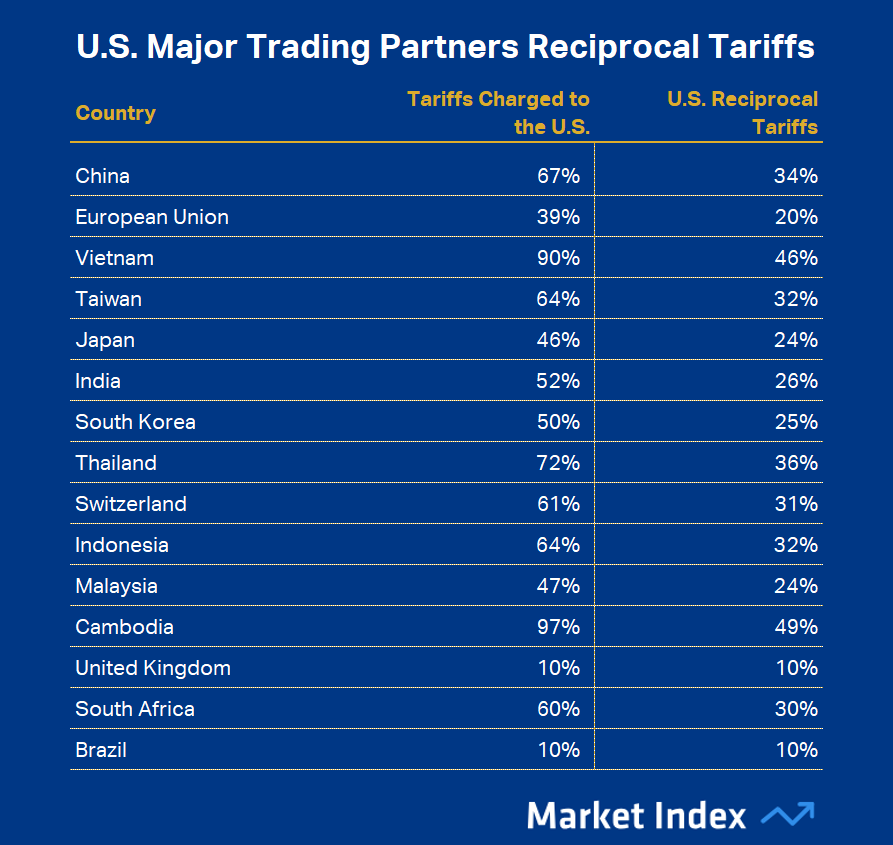Why Trump’s tariffs are sheer genius and now is the time to buy ASX shares
As markets reel from the latest round of trade war sabre-rattling, investors on Wall Street and here in Australia have responded in the only way they know how: Panic 😱!
The S&P 500 is down 17.5% from its recent all-time high and the tech-heavy Nasdaq – home of the Magnificent 7 that dazzled investors on the way up – is down 22.9%. Welcome to the next bear market Nasdaq investors! (A 10% or greater decline from a market peak is classified as a “correction”, while a “bear market” is classified as a 20% or greater decline from a market peak.) Our own S&P/ASX 200 is down 16.3% based on today’s open.
Investors are bracing for impact as President Trump doubles down on his radical new tariff strategy, with most economists forecasting it will raise the cost of living for average Americans, as well as pressure corporate profits as companies struggle to pass the full impact of the cost increases that they face.
But what if, just what if, the markets have it all wrong? 🤔
Could Trump’s tariffs be a masterstroke of economic genius and not a reckless folly as most experts claim? If this is the case, then today’s big drop in the ASX 200 could be the perfect time to put some cash to work.
This may be the only article you’ll read outlining the case for President Trump’s tariff strategy. It’s not an endorsement, though, and there’s no politics here – it’s simply an investigation of the other side of the coin. Chump card or Trump card? Let’s dive in!
A brief history of tariffs (and why they matter)
At its core, a tariff is a tax on imported goods. Governments impose tariffs to make foreign products more expensive, thereby encouraging consumers to buy domestically produced alternatives. While economists have long decried tariffs as growth inhibitors, they have, at times, played pivotal roles in shaping national economies.
Take the Tariff of 1816 – America's first protective tariff – designed to shield its emerging industries from British competition. Or the Smoot-Hawley Tariff of 1930, which, despite being widely blamed for deepening the Great Depression, arguably did lead to some short term benefits for domestic producers.
More recently, tariffs on Japanese cars in the 1980s nudged foreign automakers into building factories in the U.S., creating jobs and transforming American manufacturing.
How am I going at making the case for tariffs? Well, I’m doing my best! Let’s just say that tariffs have historically been used as blunt instruments, often yielding mixed results. But in the hands of an artful dealmaker like Trump, could they be something more?
Trump’s new tariff regime: Why this time will be different
Hold that thought! Let’s investigate Trump’s new tariffs in greater detail. Perhaps there’s more than meets the eye. They’re certainly one of the most aggressive pivots toward economic nationalism – designed to combat what the Trump administration calls "chronic trade abuses," by the US’ trading partners.
The policy targets both allies and adversaries alike, as can be seen in table below:

Trump administration’s latest tariff schedule for US's top trading partners
President Trump’s team argues these measures will revive American industry, reduce dependency on hostile trade partners, and reassert US leverage in the global marketplace. On the other hand, critics call it economic suicide. This is because conventional economic wisdom says tariffs lead to higher consumer prices, retaliatory trade wars, and slower global growth.
But maybe, just maybe, the critics are thinking too small this time. Here’s where things get spicy. First, the global supply chain has grown so convoluted and dependent on China, that tariffs may finally force a necessary diversification of US firms’ sourcing of labour, manufacturing, and pre-finished goods.
If the highly punitive tariffs on Chinese imports cause American firms to begin sourcing from more-trusted countries (like Australia) or reshoring production altogether, the long-term payoff could be greater independence from China and more robust supply chains. All of this would flow through to greater US (and our) national security.
Second, targeted tariffs can incentivise US innovation. When foreign ingenuity becomes costlier, US firms must invest more in R&D, upskill labour, and scale their domestic operations. Trump’s 2018 steel tariffs, for example, subsequently prompted US mills to reopen in Ohio and Pennsylvania.
Third, and this is the geopolitical wildcard, Trump’s tariffs may reset global trade norms. If the US protectionist tariffs work, then other nations may follow, creating a new paradigm where strategic trade policy is used to increase sovereign leverage. OK, as an economist this last one scares me, but perhaps it also creates opportunities for countries like Australia to make smarter trade deals and perhaps fill some of the void of US-China trade with both parties.
This could be the best thing that ever happened to the ASX – and your portfolio
On that last point – how Australia, and by extension ASX companies, may benefit from Trump’s trade war – in a weird twist of fate, we are potentially one of the few countries that may come out way ahead.
Consider this. If Australia has only copped a 10% "reciprocal tariff", and most other of the US' major trading partners copped substantially more...doesn't that mean our exports to the US just got SUBSTANTIALLY more competitive? Whatever little that is, of course, but it still represents an opportunity for many Australian exporters.
Also, if Chinese manufacturers look to divert their exports away from US markets then, we could be on the cusp of a wave of cheap goods coming our way – everything from EVs to TVs. This would lower our inflation, and therefore facilitate lower local interest rates – putting more dollars back in our household budgets and bolstering the bottom lines of ASX stocks both from the revenue and expenses sides.
Higher revenues versus lower expenses equals greater profits, and greater profits usually equals greater share prices. Win, win, win.
More broadly, if tariffs lead to a stronger and more secure US economy, that will only be a good thing for stocks in the long run also. It should mean lower, not higher volatility in US stock markets, interest rates, and a strong US economy is good for global growth.
So, perhaps President Trump is playing 4D chess while the rest of the world’s global leaders and lowly economists like me are playing checkers? Time will tell. But one thing is certain: The old economic rules are being rewritten. And in this new game, betting against The Donald might just prove to be the real folly.
It could be genius looks more like the image on the right than the left!

Could President Trump be the “Einstein” of modern economics? (Photo by Chip Somodevilla/Getty Images)
Think I'm onto something here, or are markets and economists right 🤔? Let me know in the comments below 👇!
This article first appeared on Market Index on Monday 7 April 2025.
5 topics
9 stocks mentioned

